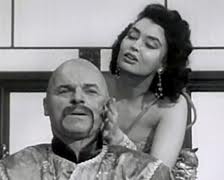TV Review: The Adventures of Dr. Fu Manchu
Fu Manchu is the greatest of the Yellow Peril villains, created during a time period when it was believed that “sinister Chinamen” plotted to overthrow the Western nations and bring the world under Asiatic control. The first Sax Rohmer Fu Manchu novel, The Insidious Dr. Fu-Manchu, was published in 1913, having first appeared as a series of magazine stories.
In 1956, a television program aired featuring Glen Gordon as the Devil Doctor (Fu Manchu has almost never been played by an actual Chinese actor), with Lester Matthews as his long-time nemesis Sir Denis Nayland Smith, formerly of Scotland Yard. In the books, Fu Manchu’s motivation had evolved from smashing the British Empire and by extension all Western civilization, to taking over the world for its own good to prevent war and chaos. For the TV series, he was portrayed as mostly wanting to create war and chaos so that he could then take over the world.
Due to rights disputes with Mr. Rohmer, the series was truncated at thirteen episodes, two of which I have on DVD. Each episode opens with a chess game between Sir Denis and Fu Manchu, representing white and black respectively. (The symbolism takes on a slight tinge when you remember that white attacks first.) At the end of each episode, Dr. Fu Manchu is thwarted, and breaks one of the black pieces in anger.
Fu Manchu is aided in each episode by the lovely Egyptian slave girl Karamaneh (Laurette Luez) and the little person Kolb (John George). Other minions are guest stars, and tend to die during the course of the episode. Sir Denis is assisted by Dr. John Petrie (Clark Howat), who is attached to the Surgeon General’s office, and Dr. Petrie’s lab assistant Nurse Betty Leonard (Carla Balenda).
“The Prisoner of Fu Manchu”: Fu Manchu hypnotizes Betty into injecting an Asian diplomat with a formula that puts him into a coma just before an important peace conference. This is part of an elaborate ploy to replace the diplomat with an impostor, kill all the diplomats to ensure war, and steal a new type of radiation shielding being demonstrated at the conference. The most interesting twist here is that the impostor pretends to be partially paralyzed from the effects of the poison, thus drawing attention to that rather than any defects in his impersonation.
“The Ships of Death”: A ship sinks off Hong Kong in heavy weather, but the seasoned captain saves the entire crew, and some special cargo. The captain is unaware that his precious cargo is actually stolen germ warfare samples from an American government facility. (Naturally, they were only created to help Americans defend against germ warfare.) If these samples fall into the hands of the Reds, they’ll be able to use them as an excuse to step up their own germ warfare research and possibly utilization. Fu Manchu blackmails the captain into accepting the job of delivering the cargo, and injects the samples into melons for smuggling purposes. The captain decides he cannot be a part of this, and by the end, Fu Manchu himself narrowly escapes an infectious death.
Keeping in mind the technical limitations of 1950s TV, and the attitudes towards racism of the time, these episodes are pretty exciting and well-shot. Glen Gordon is enjoying himself, and Laurette Luez is a sultry femme fatale.
This show is perhaps best watched in contrast with a modern depiction of Asian people to remind us how attitudes have changed, or so we would like to believe.


The actors name is actually Glen Gordon…
Updated! Thanks for the catch!